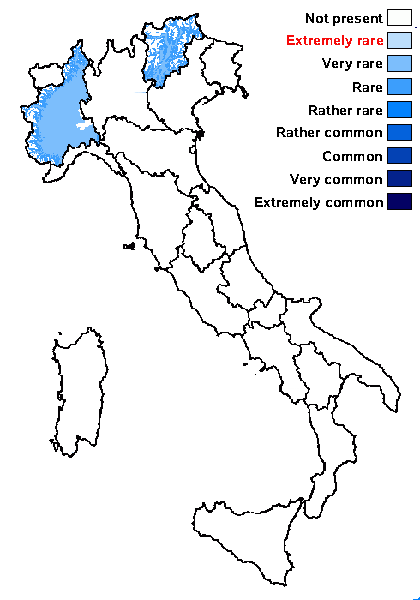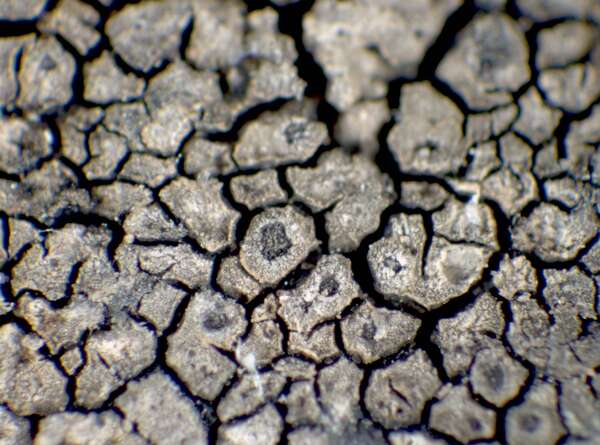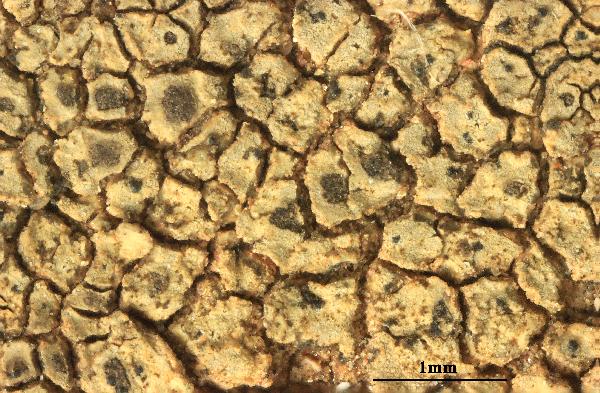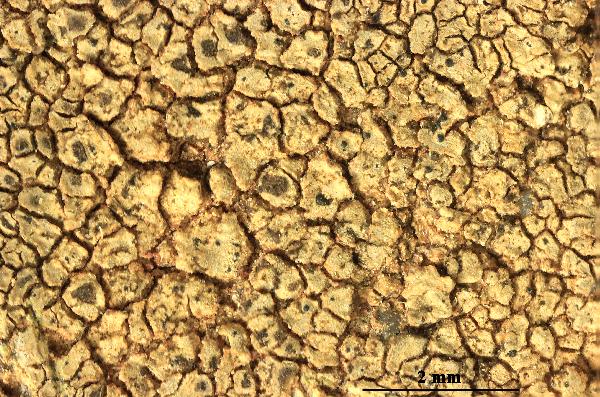Rinodina cana (Arnold) Arnold
Verh. zool.-bot. Ges. Wien, 30: 125, 1880. Basionym: Rinodina arenaria var. cana Arnold - Flora, 55: 289, 1872.
Synonyms:
Distribution: N - TAA, Piem (TSB 34548).
Description: Thallus crustose, episubstratic, rimose-areolate, grey to ochraceous brown, the areoles contiguous, flat, often brownish to greenish and N+ purple at margins and on lower side. Apothecia aspicilioid, immersed in the areoles, 0.2-0.4(-0.7) mm across, with a concave to flat, brown to black, often faintly grey-pruinose disc and a thin, persistent thalline margin. Epithecium orange-brown to dark brown, with an epipsamma of small crystals dissolving in K, K-; hymenium colourless, 90-110 µm high; paraphyses c. 1.5 µm thick at mid-level, the apical cells 3-5 µm wide, with a brown cap; hypothecium colourless, up to 150 µm high. Asci 8-spored, clavate, the K/I+ blue tholus penetrated by a faintly amyloid apical cushion with parallel or diverging flanks, the wall K/I-, surrounded by a K/I+ blue outer layer, Lecanora-type. Ascospores 1-septate, pigmented, ellipsoid, (16-)18-22(-24) x 9-12(-13.5) µm, Milvina-type grading into the Pachysporaria-type, with a poorly developed torus, the ontogeny of type A (apical wall thickening after septum formation). Photobiont chlorococcoid. Spot tests: K-, C-, KC-, P-. Chemistry: without lichen substances.Note: on steeply inclined surfaces of weakly calcareous schists and basic siliceous rocks, most frequent in dry-warm areas; certainly overlooked and more frequent, at least in the Alps, mostly below treeline.
Growth form: Crustose
Substrata: rocks
Photobiont: green algae other than Trentepohlia
Reproductive strategy: mainly sexual
Commonnes-rarity: (info)
Alpine belt: absent
Subalpine belt: rare
Oromediterranean belt: absent
Montane belt: rare
Submediterranean belt: very rare
Padanian area: absent
Humid submediterranean belt: absent
Humid mediterranean belt: absent
Dry mediterranean belt: absent

Predictive model
Herbarium samples


P.L. Nimis; Owner: Department of Life Sciences, University of Trieste
Herbarium: TSB (21833)
2001/11/29


Felix Schumm - CC BY-SA 4.0
[VZR], Hispania. València: In monte El Garbi dicto, prope urbem
Sorra, 575 m. Ad saxa quarcitica. Leg. B. Calatayud, 18.10.1992, conf.
H. Mayrhofer. EX A. VEZDA: LICHENES RARIORES EXSICCATI NR. 187.
Growth form: Crustose
Substrata: rocks
Photobiont: green algae other than Trentepohlia
Reproductive strategy: mainly sexual
Commonnes-rarity: (info)
Alpine belt: absent
Subalpine belt: rare
Oromediterranean belt: absent
Montane belt: rare
Submediterranean belt: very rare
Padanian area: absent
Humid submediterranean belt: absent
Humid mediterranean belt: absent
Dry mediterranean belt: absent

Predictive model
| Herbarium samples |


P.L. Nimis; Owner: Department of Life Sciences, University of Trieste
Herbarium: TSB (21833)
2001/11/29


 INDEX FUNGORUM
INDEX FUNGORUM
 GBIF
GBIF
 DOLICHENS
DOLICHENS




